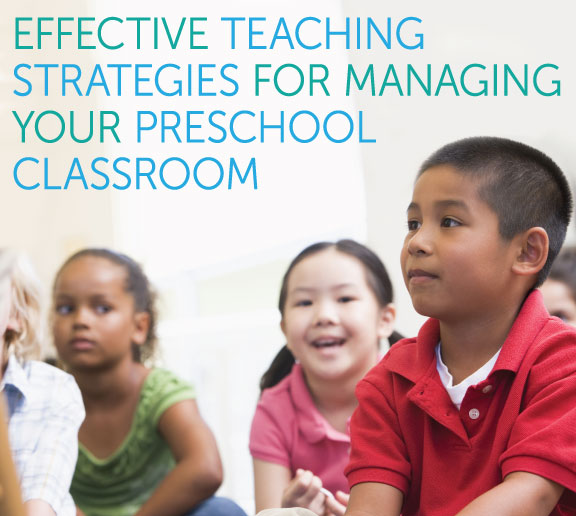Effective Teaching Strategies for Managing your Preschool Classroom
May 28th, 2015 | 3 min. read
By Jenna Roby


Many preschool teacher resource books offer teaching strategies for classroom management based on challenging behaviors. But that leaves a lot out of the typical classroom rules.
In their invaluable book, Preschool Classroom Management, veteran teachers Laverne Warner, PhD, and Sharon Anne Lynch, EdD, offer 150 ideas for successful teaching and learning. From organizing centers to handling tattling and foul mouths, their deep expertise lays a plan for how new and experienced teachers can improve their classroom outcomes.
Here are just a couple of their great pieces of advice:
Addressing the Behavior, Not the Child
The Issue:
When you handle behavior problems in the classroom, it is important to separate children from their behavior and address the behavior only. This approach is likely to be more successful in helping children change their behavior.
Overview:
Preschool children are sensitive to how adults assess their behavior. They want to be liked, and they are often guilty when they have behaved negatively. To avoid producing guilt feelings in young children, address their behavior, not the whole child.
Goal:
To have children feel accepted as people when confronted with their negative behaviors, instead of feeling belittled.
Solutions:
The following are good examples of comments by teachers who value children, but must correct certain behaviors:
- "Lana, your talking during story time was a problem today. I know you forgot the rule about no talking during story time. How can we solve this problem tomorrow?"
- "Josh, you know I think you have many talents, including having strong muscles. But when you kick others in the classroom, you create problems for your friends and yourself. Let's talk about what you can do instead."
- "Just because you disobey the rules, Kirk, doesn't mean you're bad. What it means is that you've forgotten why we have rules. We have rules so we can have a happy classroom. Let me show you how to work with others in the Block Corner."
- "Jodie, you don't feel well today, do you? That makes you irritable and it appears you don't want to get along with your classmates. Come talk to me about what you are feeling."
In each of the above examples, the teacher addressing the child's behavior, not the child.
Keys to Effective Classroom Management
Teachers are human, so if you lash out in anger to children, apologize and tell them that you made a mistake.
Planning Ahead
The Issue:
It's important to think through the consequences of an instruction. For example, if you say, "It's time to go outdoors to play," the children immediately rush to the exit. Indeed, it may be time to go outside and play, but you need a plan of action for getting the children ready to depart for the playground.
Overview:
Your number one responsibility in a classroom is the safety of the children. Taking time to plan for changes in the schedule, for moving from one part of the building to another, and for transitions from school to home are critical components of each day.
Goal:
To keep children safe and orderly, because children are not always aware of impending dangers.
Solutions:
The following scenarios describe teachers who plan ahead:
- Ms. Motley's three-year-olds can be a handful, but she is enjoying working with each of them. She learned early in the school year that confusion erupts when she asks, "Do you want to hear this book again?" Some do, while others don't. Ms. Motley corrected this chaos by saying instead, "Let me read this book again."
- Mr. Larry has observed that his children are unaware that the street next to his school has a lot of traffic. Although there is a fence around the playground and the gate has a security latch, he is still concerned that one of his youngsters might wander into the street. He has talked with the director about providing a safety guard during outside playtime, and for arrival and dismissal times. He has suggested that the parents of the children may want to volunteer to provide this service.
- Mrs. Gilliam developed a system for collecting lunch money that saves her precious time each morning. When the children arrive at school, they drop their lunch money into an envelope that has their name on it and is attached to a poster on the classroom door. When children are engaged in classroom center experiences, Mrs. Gilliam is able to count the money without interruption.
- Ms. Jay knows that taking her children to the school library can be a challenge because it is a long walk. Her solution is that the librarian and her assigned aide meet the class halfway. This allows Ms. Jay to return to her classroom to organize for other events children have scheduled for the day.
Keys to Effective Classroom Management:
Before the school year starts, scrutinize the classroom and playground for impending dangers. Eliminate hazards, and before the children arrive, spend time thinking about how to keep them safe. For example, remove pieces of furniture that are worn and might break if sat on, or take away broken glass from the playground if it has become a dumping ground by thoughtless neighbors.
Give children specific directions to minimize chaotic responses to classroom procedures.
Author(s)Sharon Lynch, Laverne Warner
A graduate of High Point University, Jenna Roby served as marketing specialist for Gryphon House from 2013-2015.
Topics: